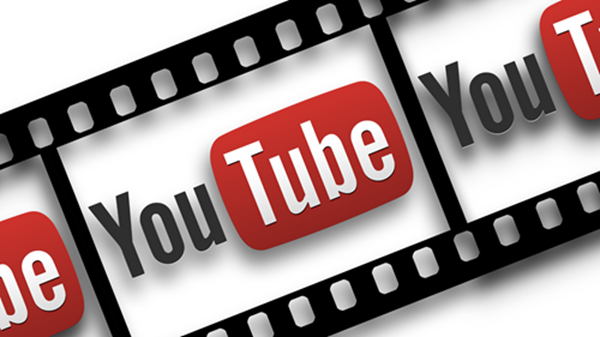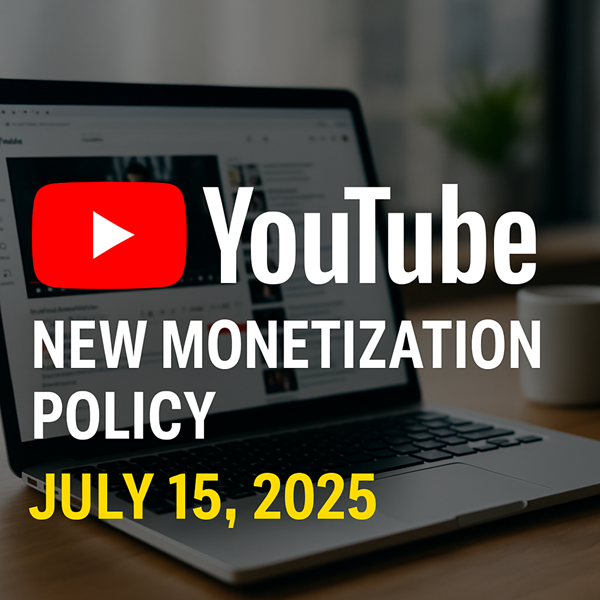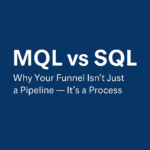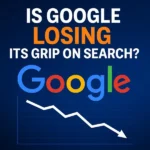Youtube New Ad Monetization Policy : The Monetization Wake-Up Call – YouTube’s Bold Move in 2025
YouTube has long been a haven for creators—from teenagers making reaction videos to professionals running entire production houses. But with the explosion of AI tools, auto-generated content, and mass-uploading tactics, the platform found itself flooded with low-effort videos, many designed solely to chase views and ad revenue.
Now, YouTube is drawing a clear line in the sand.
In a game changing update effective July 15, 2025, YouTube is tightening its monetization policies to prioritize authenticity, originality, and creative value. This isn’t just another algorithm tweak, it’s a direct challenge to copy paste creators, AI voiceover mills, and templated content farms. If you’re part of the YouTube Partner Program or plan to be, this policy update directly affects you.
So, what does this mean for creators, marketers, and digital storytellers? What’s allowed, what’s banned, and how do you stay monetized in this new ecosystem?
This blog breaks it all down—from what’s changing to what steps you need to take right now—in simple, actionable language.
YouTube New Ad Monetization Policy

1. What’s Changing?
Starting July 15, 2025, YouTube is implementing stricter standards on the content that qualifies for ad monetization under the YouTube Partner Program (YPP). The goal? Disincentivize mass-produced, repetitive, or low‑effort content that offers little value beyond generating views.
Key updates include:
- A sharper focus on originality and authenticity.
- Improved mechanisms to detect and demote “inauthentic” uploads, like templated or AI-generated videos.
2. What’s Not Allowed?
Non-original Content
- Copying from other creators or using sourced content without significant transformation.
- Slight edits—like text-to-speech voiceovers—won’t pass as original.
Repetitive or Template-Style Uploads
- Channels pushing content with minimal variation in subject, structure, or narrative.
- Examples include slideshow compilations, daily updates without unique insight, or formulaic compilations.
AI-Generated or Voice-Based Automation
- Content relying heavily on AI voice, stock footage, or recycled clips—unless deeply customized around original commentary or purpose.
3. What Is Allowed?
a. Originality is key: Your work must reflect fresh storytelling, creative insight, or unique production value.
b. Substantive transformations: Brief clips are okay when placed within commentary, critique, or analysis—where the creator clearly adds perspective .
c. Educational or entertaining value: Even if formats share similarity (like a consistent intro/outro style), the content must provide distinct viewer benefit each time.
4. Why This Policy Was Introduced
YouTube’s goal is to elevate authentic creativity and preserve advertiser trust. As automation and low-effort channels proliferated, ad revenue diluted—prompting this update to protect quality content and sustainable monetization.
5. Creator Impact: What to Expect
- Review delays: Monetization decisions may take longer as automated and human reviews ramp up to evaluate originality
- Channel-level enforcement: Monetization might be removed not just on a single video but across a channel if broader content quality is lacking .
- Potential penalties: Though unclear yet, channels could face demonetization or exclusion from YPP if violations persist
6. What Creators Should Do Now
a. Audit Your Content Library
- Flag videos with repetitive formats or those based largely on reused content.
- Identify AI-voice or stock-filmed videos lacking creator presence or unique input.
b. Revamp Your Content Strategy
- Bring more voice: Add personal commentary, context, or insight to every video.
- Deep edits: Remix clips with storytelling, graphics, subtitles, or annotations.
- Supported formats: Consider reviews, tutorials, reaction videos, or documentaries that demonstrate clear transformation.
c. Refresh Metadata & Formats
- Update titles, thumbnails, and descriptions to reflect your unique perspective.
- Maintain production consistency (e.g., intro/outro), but ensure main substance differs each video.
d. Adhere to YPP Thresholds
- Remember: at least 1,000 subscribers, 4,000 public watch-hours in last 12 months, or 10 million Shorts views in the past 90 days, still apply .
e. Utilize YouTube Tools
- Stay tuned for official guidance from YouTube before July 15.
- Monitor video statuses in YouTube Studio for newly applied monetization checks.
7. Step-by-Step: Getting & Maintaining Monetization
- Meet eligibility (subscribers + views/watches).
- Apply or reapply to YPP via YouTube Studio.
- Undergo review (AI/human) to assess originality/authenticity.
- If approved: Regular monetization.
- Maintain standards: avoid repetitive formats or untransformed reused clips.
- Regularly review analytics, demonetization flags, and YouTube updates.
Final View on Youtube New Ad Monetization Policy:
Adapt or Fade—Why This Update is a Win for Real Creators
This update is not a roadblock; it’s a filter. YouTube is telling the world that originality matters again. It’s a return to what made the platform thrive in the first place—raw talent, personal insight, and human creativity.
Yes, AI tools and automations can assist. But the message is clear: tools should empower creation, not replace it.
If you’re a creator who pours heart, voice, and vision into your content—you’ll benefit from this update. But if your channel is running on rinse-and-repeat formats or AI-cloned templates, it’s time to evolve… or risk being left behind.
The future of YouTube isn’t about who can upload more—it’s about who can connect better.
FAQ: YouTube New Ad Monetization Policy 2025
Q1. What exactly is changing in YouTube New Ad monetization policy starting July 15, 2025?
A: YouTube is updating its monetization criteria to discourage non-original, mass-produced, or AI-generated content. Videos must now reflect original input, creativity, and human perspective. Reused or templated content may no longer qualify for ad revenue.
Q2. Will my existing videos lose monetization?
A: Possibly. If your existing videos are identified as low-effort, repetitive, or reused content without significant transformation, they may get demonetized. YouTube will apply channel-level assessments in some cases.
Q3. What content types are now considered “low-value”?
A: Content that is:
- Repetitive (same script/structure over and over)
- Auto-generated or AI-voiced without editing or commentary
- Compilations with no original contribution
- Slideshows or stock videos with minimal engagement or insight
Q4. Can I still use AI tools in my content?
A: Yes, but only if you add meaningful human value—like voiceovers with original thoughts, visual storytelling, or editorial transformation. Simply stitching together AI visuals and auto-narration will not qualify.
Q5. Will YouTube ban AI-generated content entirely?
A: No. YouTube is not banning AI—but it’s banning laziness disguised as content. AI tools can be part of the process, but you must add real, original input that enhances viewer experience.
Q6. What are some examples of acceptable content now?
A:
- Reaction or commentary videos with personal opinions
- Tutorials or explainers with original narration and visuals
- Review videos with creator insights
- Documentaries or stories using curated clips + added context
- Original vlogs, music, animations, and skits
Q7. What steps should I take to keep monetization on my channel?
A:
- Audit your content – Remove or edit any templated, low-effort videos.
- Add your voice – Use real commentary, storytelling, and editing.
- Stop copying – Avoid using existing videos unless transformed substantially.
- Follow YPP rules – Meet 1K subscribers + 4K hours/10M Shorts views.
- Stay updated – Check YouTube Studio for policy compliance alerts.
Q8. How will YouTube enforce this?
A: YouTube will use a combination of automated detection and manual review. Some channels may face monetization denial or removal if found consistently violating these guidelines.
Q9. Can I appeal if my monetization is rejected under the new policy?
A: Yes, creators can reapply for monetization after 30 days—but they’ll need to ensure their content meets the updated originality standards before reapplying.
Q10. Will this impact Shorts and Livestreams too?
A: Yes. Shorts must show creative transformation, and livestreams should reflect original engagement and not rebroadcast or mimic existing shows.
For more such Digital Marketing Updates, Follow Popnewsblend.com.

Hi, I’m Prashant Jain — a curious soul, storyteller, and content creator at heart.I’ve always been drawn to the world of entertainment, travel, sports, health & lifestyle — not just as a writer, but as someone who genuinely lives these experiences. Whether I’m binge-watching the latest OTT series, exploring offbeat spiritual destinations in India, or diving deep into wellness routines and cricket match insights, I love sharing what I discover with like-minded readers.
PopNewsBlend is my way of blending personal journeys with meaningful stories — ones that inform, inspire, and keep you ahead of the curve. Everything I write comes from real observations, hands-on experiences, and a deep passion for understanding the world around us.
Discover more from Popnewsblend
Subscribe to get the latest posts sent to your email.







